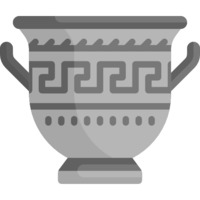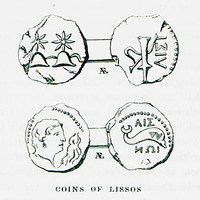Αρχαία Λισσός
Αντικείμενο
Τίτλος Σημείου Ενδιαφέροντος
el
Αρχαία Λισσός
en
Archaia Lissos
Περιγραφή / Απόσπασμα
125-134
en
Α few observations are demanded by the peculiar situation of this ancient city, on account of the influence which such towns must have had on the Dorian institu tions of the island.
Σύγχρονη περιγραφή
el
Ο αρχαιολογικός χώρος της Λισού βρίσκεται στη νότια ακτογραμμή του νομού Χανίων, ανάμεσα στην Παλιόχωρα (δυτικά) και τη Σούγια (ανατολικά). Η Λισός, ήταν επίνειο, δηλαδή λιμάνι, της Υρτακίνας και υπήρξε μία σημαντική, αυτόνομη πόλη της Κρήτης με συγκρότηση από τους κλασικούς χρόνους μέχρι και τον 7ο ή 9ο αιώνα μ.Χ., οπότε και φαίνεται ότι καταστράφηκε οριστικά, χωρίς να ξανακατοικηθεί. Κατά την Αρχαιότητα, η πόλη ήταν γνωστή για το περίφημο Ασκληπιείο της, όπου θεραπεύονταν ασθενείς από όλη την Κρήτη χάρη στα ιαματικά νερά της περιοχής και για το λόγο αυτό δεν διέθετε οχύρωση για προστασία της. Ο ναός του Ασκληπιού ήταν δωρικού τύπου και είχε μικρές διαστάσεις. Κτίστηκε κατά τους ελληνιστικούς χρόνους, ενώ το θαυμάσιο ψηφιδωτό του δάπεδό προστέθηκε κατά την μετασκευή των ρωμαϊκών χρόνων. Ο ναός βρέθηκε καταπλακωμένος από υπερμεγέθεις βράχους που είχαν κυλήσει από ψηλότερα προφανώς εξαιτίας κάποιου ισχυρού σεισμού, σφραγίζοντας μέσα του: μια εξαιρετική συλλογή ελληνιστικών γλυπτών- αναθημάτων των προσκυνητών με τα ονόματά τους στα βάθρα και το άγαλμα του ίδιου του Ασκληπιού. Το ιερό ήταν σε ακμή μέχρι τη ρωμαϊκή περίοδο, ενώ κατά την παλαιοχριστιανική περίοδο έγινε μάλλον κάποια προσπάθεια εξαγνισμού του ναού, όπως μαρτυρούν οι χαραγμένοι σταυροί στις τοιχοποιίες. Ο χώρος είναι διάσπαρτος με αρχαία ερείπια δημόσιων κυρίως κτηρίων, αλλά και έργων υποδομής, όπως οι ρωμαϊκές θέρμες, το αρχαίο ωδείο, το οποίο δεν έχει ανασκαφεί, η νεκρόπολη με 118 τάφους, τα απομεινάρια από το Ρωμαϊκό θέατρο, δεκάδες αγάλματα καθώς και αρχαία νομίσματα.
Σήμερα, η ευρύτερη περιοχή παραμένει ένα σημαντικό θρησκευτικό κέντρο, αφού υπάρχουν οι εκκλησίες της Παναγίας και του Άη Κυρκού (Κηρύκου) κτισμένες πάνω σε ερείπια παλαιοχριστιανικών ναών.
Σήμερα, η ευρύτερη περιοχή παραμένει ένα σημαντικό θρησκευτικό κέντρο, αφού υπάρχουν οι εκκλησίες της Παναγίας και του Άη Κυρκού (Κηρύκου) κτισμένες πάνω σε ερείπια παλαιοχριστιανικών ναών.
en
The ancient site of Lissos is situated at the southern coastline of the region of Hania, between Paliochora (west) and Sougia (east). Lissos was a sea harbor, that is, a harbor, of Yrtakina and was an important, autonomous city of Crete with establishment since the classical age, up until the 7th or 9th century AD, when it seems that it was totally destroyed, without it being re-inhabited again. During antiquity, the city was famous for its well-known Asklipieion, where patients from all over Crete were treated thanks to the thermal baths of the area, and for this reason it did not have walls for its protection. The temple of Asclepius was of Doric style and was rather small. It was constructed during Hellenistic times, while its marvelous mosaic floor was added after the later reconstruction during Roman times. The temple was found under huge rocks that probably fell from a higher level due to a strong earthquake, sealing within it: an exquisite collection of Hellenistic sculptures-dedications of pilgrims with their names on the pedestals and the statue of Asklipios himself. The sanctuary was thriving up until the Roman times, while during early Christian times, there was an effort to purify the temple, as the carved crosses on the walls show. The area is filled with ancient ruins of mainly public buildings, as well as infrastructure works, such as the Roman thermal baths, the ancient Odeon, which has not been excavated yet, the necropolis with 118 tombs, the remains of the Roman theater, dozens of statues, as well as ancient coins.
Today, the wider area remains an important religious center, since there exist the churches of the Virgin Mary and Saint Kyrkos (Kyrikos), built on ruins of early Christian temples.
Today, the wider area remains an important religious center, since there exist the churches of the Virgin Mary and Saint Kyrkos (Kyrikos), built on ruins of early Christian temples.




